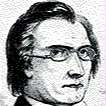
1793 - 1850
John White Webster
Summary
Name:
John White WebsterYears Active:
1849Birth:
May 20, 1793Status:
ExecutedClass:
MurdererVictims:
1Method:
BeatingDeath:
August 30, 1850Nationality:
USA
1793 - 1850
John White Webster
Summary: Murderer
Name:
John White WebsterStatus:
ExecutedVictims:
1Method:
BeatingNationality:
USABirth:
May 20, 1793Death:
August 30, 1850Years Active:
1849Date Convicted:
March 30, 1850bio
John White Webster was born on May 20, 1793, in Boston, Massachusetts, into a well-established New England family. His lineage traced back to the early colonial elite: his mother, Hannah (White) Webster, descended from John Leverett, an early governor of the Massachusetts Bay Colony, while his family had ties to the Prescotts, a prominent Massachusetts family. These connections placed Webster firmly within Boston’s intellectual and aristocratic circles.
He graduated from Harvard College in 1811 and soon pursued further studies in medicine. Around 1815, Webster traveled to London, where he studied at Guy’s Hospital, rotating between surgical and medical roles. In 1817–1818, he practiced medicine on the island of São Miguel in the Azores, where he married Harriet Fredrica Hickling, daughter of the American vice-consul and wealthy merchant Thomas Hickling. The couple had four daughters.
After returning to Boston, Webster attempted private medical practice but struggled professionally. In 1824, he was appointed as a lecturer in chemistry, mineralogy, and geology at Harvard Medical College, and in 1827, was promoted to the prestigious Erving Professorship. He gained a reputation as a charismatic, if somewhat theatrical, lecturer, captivating students with dramatic chemical demonstrations—sometimes bordering on dangerous.
Contemporaries described him variously: Oliver Wendell Holmes Sr. called him pleasant but excitable, while others noted his eccentric behaviors, including an anecdote from Henry Wadsworth Longfellow where Webster simulated a hanging during a dinner party by placing a noose around his neck and staging a gruesome performance using chemicals.
Despite his popularity as an academic, Webster faced financial ruin. His salary was insufficient for his lifestyle, and he had become deeply indebted, particularly to prominent physician and philanthropist Dr. George Parkman, whose aggressive collection methods would set into motion one of the most sensational criminal trials of the 19th century.
murder story
On November 23, 1849, Dr. George Parkman, one of Boston’s wealthiest citizens and a major benefactor of Harvard Medical College, disappeared. He was last seen entering the Harvard Medical College, where he had gone to collect on a debt owed to him by John White Webster, who had borrowed heavily from Parkman and mortgaged personal items to secure his loans.
Days passed with no sign of Parkman. Suspicion eventually fell on Webster when Ephraim Littlefield, the college janitor, noticed strange behavior: locked doors, frequent fire usage from the laboratory furnace, and attempts to bribe him. Acting on his instincts, Littlefield broke into Webster’s private laboratory and discovered human remains hidden beneath a privy vault and in the laboratory furnace.
Authorities were called, and fragments of bone, a partial jaw with false teeth, and other human remains were collected. Forensic dentistry played a pivotal role in identifying the remains as those of Parkman, making the case one of the first in U.S. history to use dental evidence in a murder trial.
Webster was arrested on January 26, 1850, and charged with murder. His trial, beginning in March 1850, became a national spectacle—often referred to as the "Case of the Century" for its legal complexity and use of scientific evidence. Under Massachusetts law at the time, Webster could not testify in his own defense. Despite questions over the completeness of the evidence and prosecutorial conduct—including the involvement of Judge Lemuel Shaw, a relative of the victim—the jury was instructed to return a guilty verdict.
The prosecution maintained that Webster had murdered Parkman to avoid public disgrace and ruin, subsequently dismembering and attempting to cremate the body in his chemistry lab. The verdict of guilty was returned, and Webster was sentenced to death by hanging.
Despite multiple appeals and public debate over the fairness of the trial, the sentence stood. On August 30, 1850, John White Webster was publicly hanged at Leverett Street Jail in Boston. He maintained his innocence for much of the proceedings, although some sources later indicated he may have admitted guilt shortly before his execution.
Controversy lingers over Webster’s guilt. Later legal experts, including Robert Sullivan, former chief criminal prosecutor for Massachusetts, questioned the validity of the evidence and suggested that the actual killer may have been Ephraim Littlefield, the janitor who found the body and testified against Webster. Despite this, the verdict stood, and the case became a landmark in forensic science and American legal history.
The Parkman–Webster murder case remains a cornerstone of early forensic criminology, widely studied and dramatized in radio, television, and literature. The image of the respected professor turned killer shocked the nation and ensured that John White Webster’s name would remain infamous in the annals of American crime.